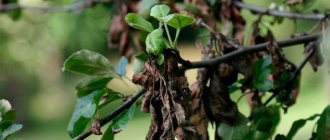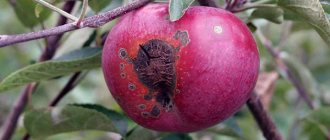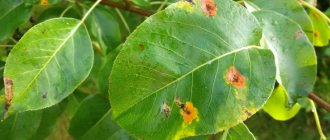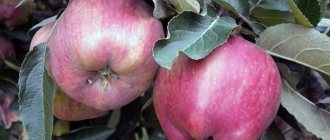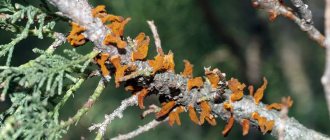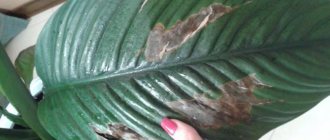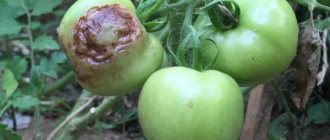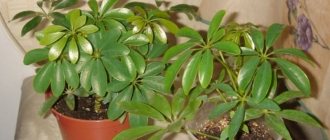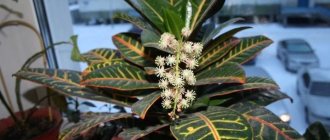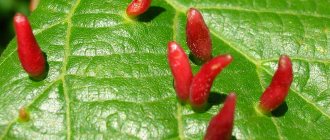Gardening » Pear
0
1810
Article rating
Kira Stoletova
When growing a pear tree, you may notice that the pear fruit turns black. This indicates the development of a dangerous disease called scab. It also affects leaves and shoots, as a result of which the yield of the crop and its winter hardiness decrease, and the quality of the fruit deteriorates.
Why does the pear fruit turn black?
Possible reasons
Pears turn black when scabbed. The problem can develop both before fruit production begins and after the fruit has been harvested. Scab is a disease that is caused by a fungus when there is an increased level of moisture. You can see a dense coating on the pears. The risk of disease decreases with heat and drought. When figuring out why fruits have black spots inside, you need to understand that scab is the most common pathology.
Attention! In spring, after rains, the wind carries the fungus from old foliage to pear plants.
Suitable conditions for pathology:
- Rains in the spring and cool summer season - the optimal temperature for the development of the fungus is +19-25 ° C, but infection is possible at temperatures of +2-3.
- High moisture level.
- The fungus may dissipate until mid-summer. However, mass reproduction occurs before the tree blooms, when the leaves bloom and budding occurs.
In the heat and drought of summer, trees may not get sick. But there is a risk when there is heavy dew. This significantly increases the moisture level.
What causes blackening?
If the above symptoms do not apply, the cause may be a crop disease. Its causative agent may be an infection.
Bacterial burn
The dark frame along the edges of the leaf absorbs the entire leaf plate, then it dries out and curls up. The disease mainly affects young trees under ten years of age. Without taking emergency measures, death occurs and this process begins from the central part of the tree. Old trees are practically not affected, because young pear branches are tender, with active sap flow, but weak immunity. There are varieties that are inherently resistant to various diseases.
Scab is caused by a marsupial fungal pathogen
It appears on the reverse side of the leaf plate as black dots, then they move on to the shoots, flowers and fruits. The shoots are covered with swollen cracks, which the pathogens use for wintering.
Pests also overwinter well under leaf fall; their favorite habitat is rainy weather, heavy dew, warmth and high humidity. To eliminate the risk of infection, leaf litter is raked and burned off-site. It can be put into compost, but it must ferment for at least two years.
Pear leaves also turn black from dry air and low humidity. Sometimes even frequent watering does not help the plant. Southern varieties are especially sensitive to growing conditions that are unsuitable for them. Gardeners with experience in such cases use drip irrigation of the crown.
One of the main distributors of plant diseases is aphids. This is a parasitic enemy of fruit trees. You need to get rid of it quickly. Drinking sap from the crown, it exhausts and dehydrates the tree; lifeless leaves become black and curled into a tube.
Scab symptoms
After the defeat, the scab makes itself felt within 14-21 days. It is important to identify the disease as early as possible. When shoots are injured, small blisters can be seen on the bark in which fungal spores develop. After a certain period, these places will crack due to the pressure of conidia. The bark will peel off.
The symptoms are as follows:
- Black spots on fruits with a velvety coating - the flesh under the painful places is loose, after a certain period you can see cracking of the tissues. Round greenish-olive spots on the foliage, initially inconspicuous, but then darken.
- Deformation of fruits - aesthetics are lost. The affected foliage, buds, and fruits fly around.
- If the plant gets sick in the spring, then the spots on the leaves are large. If later, then the spots are small. Sometimes the disease affects the crop before fruiting. Then the blackness is almost invisible, but will show itself when preserving the fruit.
Flowers, stalks, and cutting parts are also affected.
If the trunk turns black
This type of blackening of the pear is less common than the others, and most often the cause is black cancer. This disease spreads to the bark of branches and trunk.
First, small black spots of depressed shape appear on the bark, some of which then begin to secrete liquid - gum. Wounds form, sometimes extensive, and the bark may soon turn completely brown. In addition to damaging the trunk, black cancer spreads to the leaves and fruits, covering them with reddish spots. If the disease spreads severely, the tree will die.
It must be said that black cancer has no cure, and the main measures to combat it are preventive measures. For this purpose, all affected parts of the plant are removed, and if the tree is significantly affected by cancer, it is cut down and burned. If the disease is still in its early stages, it is necessary to cut off all cancerous parts to the border with healthy ones. The wounds are treated with copper sulfate and covered with a solution of clay and mullein. It may also be useful for you to know what late varieties exist for the Middle Zone.
Harvest conservation measures
Therapy is necessarily comprehensive. Delaying treatment is fraught with danger. Complications may begin. In the absence of disease, it is imperative to carry out prevention. This is ideal for protecting the pear plant and plantings. If the pears on the tree turn black, what to do is described below. If left untreated, the plant dies. The fungus spreads to all garden plants.
Chemical treatment
Drug treatment of fungus is more effective. The epidemic can be stopped. The first time the treatment is carried out before the buds open. With proper therapy, pears will not lose their aesthetics. For the first treatment, Bordeaux mixture 3% concentrate is used. It is necessary to spray every 14 days. Approximately 5 treatments are carried out per season. Additionally, fungicidal preparations are used. The following chemicals are often used:
- Speed
- Strobe.
- Horus.
Attention!
Chemicals for processing are prepared strictly according to the instructions. When using such drugs, be sure to protect the body, wear protective clothing, gloves, a robe, and a hat.
May be interesting Pear leaves turn black: causes and treatment methods Spring pear care is the basis of the harvest Pear scab: description of the disease with photographs and methods of treatment
Be sure to use a respirator. To destroy parasites that infect pear fruits, chemicals and biological agents are used in practice:
- The plantings are treated in the spring with copper sulfate (3% concentrate) or Bordeaux mixture (1%). This helps as a preventative measure for the growth of moss and lichen. Treatment with a 0.2% solution of karbofos (until color) will help in the fight against copperhead.
- You can use preparations based on yarrow, tansy or raw tobacco (0.4 kg of any herb, brew 3 liters of boiling water and let stand for 24 hours).
- Aphids can be destroyed by treating with the following product: 200 ml of alcohol and 600 ml of water + a spoon of liquid soap. The treatment is carried out in the morning. The chemicals Intavir or Decis, which are prepared according to the instructions, will help against the gall mite.
In case of serious damage, the fruit tree must be treated with insecticidal preparations (Fitoverm, Fufanon or Alatar) prepared according to the instructions. Only by following the recommendations can you overcome pear diseases.
Folk remedies
When the pear begins to turn black with spots inside and outside, you can try an unconventional treatment. If the area affected by the fungus is not yet huge, you can use folk remedies. They do not help as actively as fungicidal agents, but they have a certain advantage - they do not harm nature or humans at all.
Among the more effective, experts highlight:
- Horsetail tincture. 1/3 of the bucket is filled with plant materials and filled with warm water, allowed to stand for 72 hours. Apply after the leaves bloom.
- Mustard powder 80 g is diluted with 10 liters in a bucket of water. In total, they are sprayed four times: at the stage of bud break, during budding, after color and during the formation of pears.
- Before bud germination, treat with a salt solution (kilo per 10 liters of water).
When it is noticed that the pear begins to darken in the later stages of plant development, the best treatment will be the comprehensive use of products. They are used according to the following scheme:
- After harvesting the fruits, foliar feeding with minerals is carried out. The air temperature should be greater than +4 °C. This increases the yield and helps against various parasites.
- In the spring season, before flowering, the tree and the tree trunk are treated with Bordeaux mixture or copper sulfate solution.
- After flowering, plantings are treated with fungicidal preparations.
- Blackened pears, foliage and other affected areas are eliminated and burned.
To prevent the development of fungus, it is necessary to treat the tree plant with medicinal preparations at certain times. You need to work when it is dry outside and there is no wind. If there is a rainstorm immediately after this, it must be treated again.
Proper care
Caring for fruit trees should begin from the time of planting. The ground around the trees should be mulched immediately after planting, which makes it possible to retain moisture for a long time and protect the top of the soil from weathering. Although the pear crop does not particularly need watering, on hot days the moisture must be increased. The pear consumes a lot of water during active growth and fruiting - during this period it is recommended to water the plantings generously at the rate of 30 buckets for each tree.
On a note!
Longevity and productivity largely depend on the proper formation of the crown part.
Peculiarities:
- To ensure good tree growth, crown formation must begin in the second year of growth.
- Many varietal pear species take a long time to form shoots, which is why strong growths remain bare for a long period and have almost no branches.
- An effective method for forming the crown part is considered to be sparse-tiered pruning, in which the skeletal branches that extend from the trunk are placed in tiers at a distance of approximately 1.5 m from each other.
When pruning using this technology, you don’t have to worry about cutting off unnecessary branches, but it’s better not to overdo it, because very short shoots can negatively affect the development of the pear tree. Unnecessary branches are cut off with a sharpened tool, while the center conductor is cut to the upper lateral skeletal branch. The height of an adequately decorated tree should not be higher than 4 meters, which will make it easier to collect fruit in the future.
Pears are more susceptible to freezing than other fruit and berry plants, so in cold weather they are insulated with snow. If the winter is not snowy, you can wrap the trunk with roofing felt material to a height of up to 800 mm or use roofing felt.
In the summer, the tree trunks are weeded, and in the autumn season, before insulation, the soil must be loosened. Maintenance measures for plantings must include treatment aimed at:
- disease prevention;
- destruction of parasites.
This work should be done several times a year: first before buds form, then before and after the tree blooms. For processing, copper sulfate is used, which gives a high effect in the fight against dangerous pests, and urea, which will significantly speed up the ovary of useful fruits. Old plants suffering from Fe deficiency can be treated with iron sulfate, which:
- enriches the pear with this useful microelement;
- will increase the amount of harvest.
In favorable years, when the fruit tree produces a large harvest, its strength is depleted, so in winter the plant may freeze. To prevent this, in the fall it is necessary to feed with nitrogen preparations, combining it with:
- loosening the earth;
- abundant watering.
This must be done as early as possible, since fertilizing just before the frost will not allow the pear to “retire” in a timely manner.
On a note!
When flowering occurs and after the ovary falls again, it is necessary to feed the tree with nitrogen, phosphorus and potassium preparations and apply the fertilizer directly into the soil around the trunk.
A solution of urea, as well as potassium permanganate, which protects against interveinal chlorosis, will also benefit.
Disease prevention
Pear trees require full care and careful attention throughout the entire cultivation period. It is necessary to cut off all dry shoots at the end of winter, before the buds begin to plump. You can trim broken, dead branches to the healthy part.
Particular care must be taken with the arrival of heat:
- They remove all fallen leaves, and also remove those that remain on the branches; they must be burned. It is also necessary to destroy mummified fruits, as they are potentially dangerous for future pears.
- They trim the crown part - this way the plants will dry out more actively after a rainstorm, abundant watering of the tree or sprinkling. If there are a lot of fruits, only large pears should be left. It is important to harvest the harvest from the tree carefully so as not to spoil the pears or break the branches.
- Each fruit is carefully inspected to prevent rotting. Treat with organic fungicidal preparations in a timely manner.
On a note!
A non-thickened crown gives almost no chance for scab, so pruning and shaping is necessary.
As the buds swell, be sure to spray with Bordeaux mixture. We must not forget about the tree trunk area, which can be affected by diseases and parasites. Before the fruits ripen, such treatments are only beneficial.
Methods to combat pear rust (video)
If the reasons are a lack of nutrients or inappropriate lighting, it is recommended to do more fertilizing with organic matter and mineral fertilizers. Complete restoration of the tree should be expected within several years.
Even the most experienced gardeners can encounter problems growing pears. Crop losses can be colossal. To avoid this, it is important to adhere to agronomic fundamentals designed specifically for pears. With proper care, trees will delight you with huge harvests of beautiful and tasty fruits.
Recommendations from gardeners
Many summer residents, through trial and error, have acquired a stock of knowledge that helps them get a rich harvest and maintain their garden area in a healthy condition. Any instrument must be disinfected with alcohol or calcined over a fire.
Perhaps their recommendations will be useful:
- The ants consume the sweet secretions of aphids and transport their larvae and adults on themselves, which leads to even greater infestation by parasites. Therefore, before destroying aphids, it is necessary to eliminate all anthills from the area.
- In hot weather, foliage and fruits may turn black from lack of water. This will cause a build-up of dust on the leaves, so it is necessary to spray the crown part with water.
- An original but effective way to treat pear diseases is to introduce solutions of antibacterial drugs into the trunk of the plant. In such a situation, the active substance quickly penetrates the plant sap, and recovery proceeds faster.
Not young pears need to be cleaned of dried bark, as dangerous parasites love to live under it.
It is sometimes problematic for a summer resident without experience to determine the causes of a particular disease of fruit trees. The recommendations will help you more easily understand the reasons for the blackness of the pear, and by applying the advice in practice, you will be able to protect your garden and get a rich harvest of fruit.
Cytosporosis, or stem rot, of pears
The causative agent of the disease is the fungus Cytospora leucostoma, which damages the bark of the tree. Cytosporosis most often appears in areas of sunburn or frost damage. As a result, the bark dries out, peels off, and becomes red-brown.
Control measures and prevention
All damaged areas of the bark are cut off and the wounds are covered with clay or garden pitch. Dry and damaged branches are regularly removed, and tree trunks are whitened in the fall.
Varieties such as Moskvichka and Yanvarskaya are resistant to cytosporosis.
